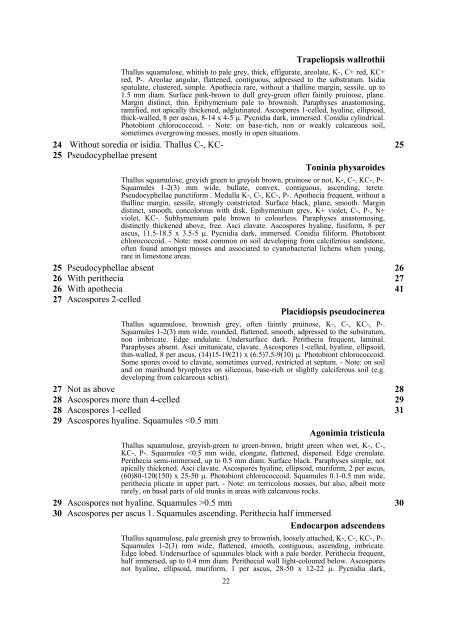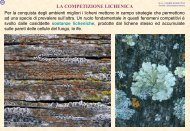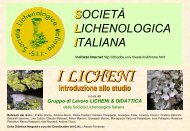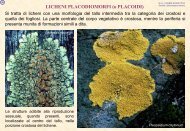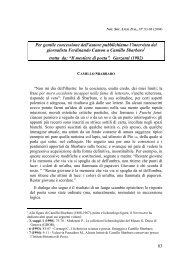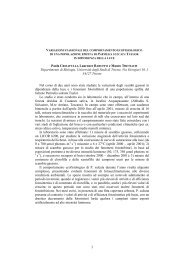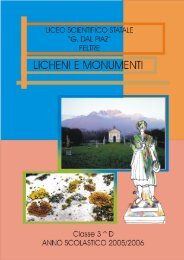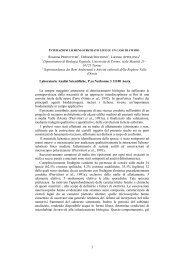KEY to terricolous lichens - italic
KEY to terricolous lichens - italic
KEY to terricolous lichens - italic
Create successful ePaper yourself
Turn your PDF publications into a flip-book with our unique Google optimized e-Paper software.
22<br />
Trapeliopsis wallrothii<br />
Thallus squamulose, whitish <strong>to</strong> pale grey, thick, effigurate, areolate, K-, C+ red, KC+<br />
red, P-. Areolae angular, flattened, contiguous, adpressed <strong>to</strong> the substratum. Isidia<br />
spatulate, clustered, simple. Apothecia rare, without a thalline margin, sessile, up <strong>to</strong><br />
1.5 mm diam. Surface pink-brown <strong>to</strong> dull grey-green often faintly pruinose, plane.<br />
Margin distinct, thin. Epihymenium pale <strong>to</strong> brownish. Paraphyses anas<strong>to</strong>mosing,<br />
ramified, not apically thickened, adglutinated. Ascospores 1-celled, hyaline, ellipsoid,<br />
thick-walled, 8 per ascus, 8-14 x 4-5 µ. Pycnidia dark, immersed. Conidia cylindrical.<br />
Pho<strong>to</strong>biont chlorococcoid. - Note: on base-rich, non or weakly calcareous soil,<br />
sometimes overgrowing mosses, mostly in open situations.<br />
24 Without soredia or isidia. Thallus C-, KC- 25<br />
25 Pseudocyphellae present<br />
Toninia physaroides<br />
Thallus squamulose, greyish green <strong>to</strong> greyish brown, pruinose or not, K-, C-, KC-, P-.<br />
Squamules 1-2(3) mm wide, bullate, convex, contiguous, ascending, terete.<br />
Pseudocyphellae punctiform . Medulla K-, C-, KC-, P-. Apothecia frequent, without a<br />
thalline margin, sessile, strongly constricted. Surface black, plane, smooth. Margin<br />
distinct, smooth, concolorous with disk. Epihymenium grey, K+ violet, C-, P-, N+<br />
violet, KC-. Subhymenium pale brown <strong>to</strong> colourless. Paraphyses anas<strong>to</strong>mosing,<br />
distinctly thickened above, free. Asci clavate. Ascospores hyaline, fusiform, 8 per<br />
ascus, 11.5-18.5 x 3.5-5 µ. Pycnidia dark, immersed. Conidia filiform. Pho<strong>to</strong>biont<br />
chlorococcoid. - Note: most common on soil developing from calciferous sands<strong>to</strong>ne,<br />
often found amongst mosses and associated <strong>to</strong> cyanobacterial <strong>lichens</strong> when young,<br />
rare in limes<strong>to</strong>ne areas.<br />
25 Pseudocyphellae absent 26<br />
26 With perithecia 27<br />
26 With apothecia 41<br />
27 Ascospores 2-celled<br />
Placidiopsis pseudocinerea<br />
Thallus squamulose, brownish grey, often faintly pruinose, K-, C-, KC-, P-.<br />
Squamules 1-2(3) mm wide, rounded, flattened, smooth, adpressed <strong>to</strong> the substratum,<br />
non imbricate. Edge undulate. Undersurface dark. Perithecia frequent, laminal.<br />
Paraphyses absent. Asci unitunicate, clavate. Ascospores 1-celled, hyaline, ellipsoid,<br />
thin-walled, 8 per ascus, (14)15-19(21) x (6.5)7.5-9(10) µ. Pho<strong>to</strong>biont chlorococcoid.<br />
Some spores ovoid <strong>to</strong> clavate, sometimes curved, restricted at septum. - Note: on soil<br />
and on muribund bryophytes on siliceous, base-rich or slightly calciferous soil (e.g.<br />
developing from calcareous schist).<br />
27 Not as above 28<br />
28 Ascospores more than 4-celled 29<br />
28 Ascospores 1-celled 31<br />
29 Ascospores hyaline. Squamules


